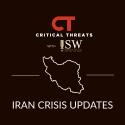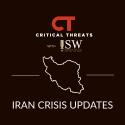Iran Crisis Update, December 1
Dec 1, 2022 - ISW PressProtesters in Zahedan, Sistan and Baluchistan Province rhetorically defended prominent Sunni cleric Moulana Abdol Hamid against the regime on December 1, underscoring the dilemma the regime faces in its protest crackdown. Protesters gathered and erected a large poster of Abdol Hamid in a city square. The poster read that Abdol Hamid is the protesters’ “red line,” implying that they will not tolerate the regime arresting him or suppressing his message. The protesters may be responding to the purported internal regime memo that the Black Reward hacker group released on November 30. The memo reported that Supreme Leader Ali Khamenei tried to discredit and threatened to arrest Abdol Hamid for his role in inspiring protests, although CTP cannot verify these claims. Abdol Hamid’s message is seemingly resonating with a growing number of Iranians, especially in the Iranian Sunni community. Any regime action to silence him risks inflaming protests and anti-regime frustrations further. The regime may target individuals close to Abdol Hamid as a less escalatory step to silence him. The protestors today posed an additional dilemma for the regime, however, since failure to act against Abdol Hamid after the erection of the poster could make it appear that the regime was daunted by the protester threats and thus encourage similar defiance and threats elsewhere.







